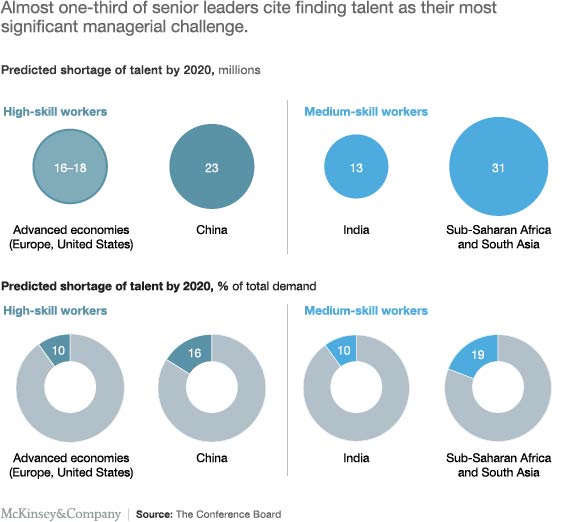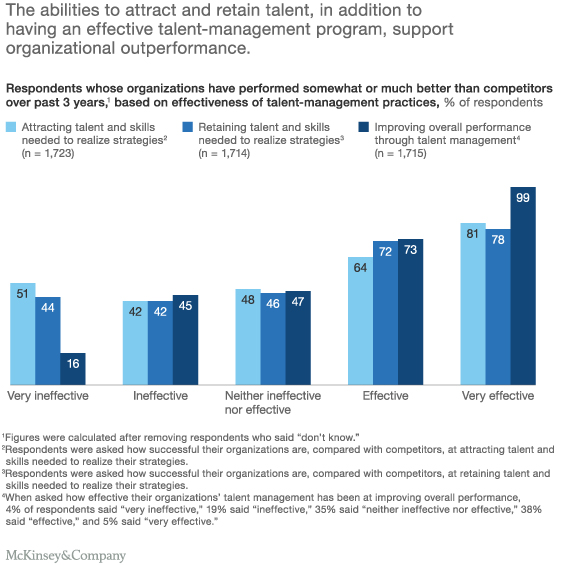As global talent is a key success factor for multinational corporations, investments made to attract and retain talent are large. Domitille Bonneton, Stephanie Katja Schworm, Marion Festing and Maral Muratbekova-Touron show how talent management practices can help retain high performers and high potential, who like other commodities have become even more scarce in these times of economic crisis.

Domitille Bonneton
ESCP Business School PhD graduate and associate professor at ESC Clermont Business School

Stephanie Katja Schworm
ESCP Business School PhD graduate and academic programme developer at Steinbeis School of Management and Innovation

Marion Festing
Professor of HRM and Intercultural Leadership at ESCP Business School

Maral Muratbekova-Touron
Professor of management at ESCP Business School
Attracting and retaining the right talent in the right places is one of the key success factors for companies in the competitive landscape of a global economy. With good reason: these high-achieving individuals are up to eight times more productive.
However, qualified talent is scarce and many employers have to cope with the so-called “war for talent”, a term initially coined by a group of McKinsey consultants, based on the research and the eponym book they published. “The war for talent shows no signs of letting up, even in sectors experiencing modest growth,” Claudio Fernandez Araoz, Boris Groysberg and Nitin Nohria wrote in the Harvard Business Review in 2011. According to a global study they conducted, only 15 per cent of companies in North America and Asia felt they had enough qualified potential successors to fill their top jobs, and the picture was only slightly better in Europe.
Despite “the economic carnage wrought by the pandemic,” it has only intensified this phenomenon, expected by some to continue through 2031, with a potential shift in power away from companies toward the workers.
McKinsey is still riding that wave, painting a similar picture in a 2017 article and talking about a new (data-driven) war for talent. “Globalization and the rise of artificial intelligence, paired with a new generation of consumers who desire more personal, intuitive brand experiences, are forcing companies to rethink their approach to talent management (TM) and acquisition. But today’s employers are struggling to keep them on board,” Margaret Rogers confirmed more recently in the Harvard Business Review. Despite “the economic carnage wrought by the pandemic,” it has only intensified this phenomenon, expected by some to continue through 2031, with a potential shift in power away from companies toward the workers.
Figure 1. Predicted shortage of talent by 2020

Companies and economies in many parts of the world have identified TM as one of the major challenges and consequently invest huge sums in it. This is especially important for multinational corporations (MNCs), which are faced simultaneously with strong global competition and local labour market challenges when filling their key strategic positions with future leaders. Economic expectations with respect to TM activities are high. For example, the Boston Consulting Group states that firms with strong TM are characterized by faster revenue and profit growth. More recently, a McKinsey Global survey confirmed the positive effects of talent management on business outcomes.
Figure 2. Performance of organisations against talent management effectiveness

The first explanatory framework of its kind
However, the discussion around TM has thus far been driven mainly by the US context and research regarding MNCs’ return on investment in terms of talent management activities, which were as scarce as qualified talent.
This is why in the course of our research published in The International Journal of Human Resource Management, we developed a conceptual framework explaining the complex relationship between TM programmes and talent retention as a key performance indicator from a career perspective. We suggested a career perspective because career-related practices are at the heart of TM. They have been studied very little in previous research within the frame of TM. Yet in this specific context, career management is crucial as individual careers have significant potential to serve the strategic purposes of organizations as investment in organizational career management is beneficial not only for the individual, but also for organizational performance.
Talent management practices have a positive effect on talent’s intention to stay, and career-related aspects are key factors in retaining this talent on a global scale.
The framework we developed to explain the underlying mechanisms that contribute to the influence of the perceived intensity of talent management practices on the intention to stay in an organization, is the first of its kind. We tested it in one MNC and thus provided first-hand empirical evidence from Europe on how global TM actually influences talents’ intention to stay based on several sources of information. Sources included 141 questionnaires completed by talent and a comparable control group, as well as information coming from several interviews with HR managers (highly valuable to conceptualize talent), and insights taken from written material.
We showed that talent management practices have a positive effect on talent’s intention to stay, and career-related aspects are key factors in retaining this talent on a global scale. This is in line with the findings of the McKinsey Global survey, which claims that “employee experience—specifically, the HR function’s role in ensuring a positive experience across the employee life cycle” is a driver of effective talent management (and thus of company performance). As well as with with some talent management practices: Jean Martin and Conrad Schmidt, from the Corporate Executive Board’s Corporate Leadership Council (now a subsidiary of Gartner), cite examples of MNCs “regularly taking the temperature” of their top talent and “paying careful attention to their satisfaction” (Shell with “career stewards”, Novartis a dedicated checklist) in China, “where finding and retaining talent is especially challenging.”
Managerial implications
The results of our study lead us to propose the following recommendations for TM programmes in MNCs:
- First, we suggest the development of talent both “on the job,” by creating international job assignments and providing the opportunity for talent to work in different subsidiaries and different countries, and “off the job,” through practices such as training modules, where all participants create and strengthen their internal talent network.
- Second, our study shows the crucial role of individual career success for talent retention, and so companies should continue to invest in career-related TM practices. We contribute to emphasizing the strategic roles of both career management and TM in relation to an organization’s performance.
- Our third recommendation concerns the “after-TM programme” period. According to some comments in our survey, talent who appreciated greatly participating in the TM programme were disappointed by the lack of career planning and development after they had finished. One talent even quit the company. It is important to keep promises; otherwise, as stated by another one, the talent pipeline that took years to build may be destroyed within only a few months. Therefore, it is important to monitor career progression, job changes, and promotions, and investment in talent development should be continuous.
This article was originally published by LSE Business Review under the Creative Commons licence CC BY-NC-ND 2.0.
License and Republishing
The Choice - Republishing rules
We publish under a Creative Commons license with the following characteristics Attribution/Sharealike.
- You may not make any changes to the articles published on our site, except for dates, locations (according to the news, if necessary), and your editorial policy. The content must be reproduced and represented by the licensee as published by The Choice, without any cuts, additions, insertions, reductions, alterations or any other modifications.If changes are planned in the text, they must be made in agreement with the author before publication.
- Please make sure to cite the authors of the articles, ideally at the beginning of your republication.
- It is mandatory to cite The Choice and include a link to its homepage or the URL of thearticle. Insertion of The Choice’s logo is highly recommended.
- The sale of our articles in a separate way, in their entirety or in extracts, is not allowed , but you can publish them on pages including advertisements.
- Please request permission before republishing any of the images or pictures contained in our articles. Some of them are not available for republishing without authorization and payment. Please check the terms available in the image caption. However, it is possible to remove images or pictures used by The Choice or replace them with your own.
- Systematic and/or complete republication of the articles and content available on The Choice is prohibited.
- Republishing The Choice articles on a site whose access is entirely available by payment or by subscription is prohibited.
- For websites where access to digital content is restricted by a paywall, republication of The Choice articles, in their entirety, must be on the open access portion of those sites.
- The Choice reserves the right to enter into separate written agreements for the republication of its articles, under the non-exclusive Creative Commons licenses and with the permission of the authors. Please contact The Choice if you are interested at contact@the-choice.org.
Individual cases
Extracts: It is recommended that after republishing the first few lines or a paragraph of an article, you indicate "The entire article is available on ESCP’s media, The Choice" with a link to the article.
Citations: Citations of articles written by authors from The Choice should include a link to the URL of the authors’ article.
Translations: Translations may be considered modifications under The Choice's Creative Commons license, therefore these are not permitted without the approval of the article's author.
Modifications: Modifications are not permitted under the Creative Commons license of The Choice. However, authors may be contacted for authorization, prior to any publication, where a modification is planned. Without express consent, The Choice is not bound by any changes made to its content when republished.
Authorized connections / copyright assignment forms: Their use is not necessary as long as the republishing rules of this article are respected.
Print: The Choice articles can be republished according to the rules mentioned above, without the need to include the view counter and links in a printed version.
If you choose this option, please send an image of the republished article to The Choice team so that the author can review it.
Podcasts and videos: Videos and podcasts whose copyrights belong to The Choice are also under a Creative Commons license. Therefore, the same republishing rules apply to them.





